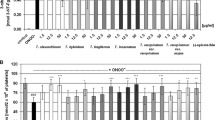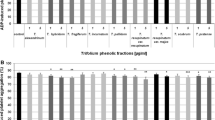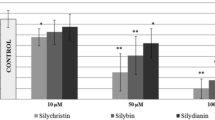Abstract
Beneficial effects of the antioxidant L-ascorbic acid (Asc) in human health are well known. Its particular role in hemostasis deserves further consideration, since it has been described a dose-dependent effect of Asc in platelet activity. Contrary, it has been demonstrated that phenolic compounds have inhibitory effects on platelet aggregation stimulated by the physiological agonist thrombin (Thr). Here, we have evaluated the actions of three synthetic phenolic esters of Asc: L-ascorbyl 6-protocatechuate (Prot Asc), L-ascorbyl 6-gallate (Gal Asc), and L-ascorbyl 6-caffeate (Caf Asc). All these Asc derivatives exhibited greater radical scavenging activity than Asc, and in experiments using human platelets from healthy subjects, they do not evoke changes in platelet viability upon their administration. Nevertheless, these compounds altered platelet calcium homeostasis in response to Thr, although Prot Asc induced a smaller effect than Gal Asc, Caf Asc, and Asc. As a consequence, platelet aggregation was also impaired by these compounds, reporting Prot Asc and Caf Asc a weaker antiaggregant action than Gal Asc and Asc. Treatments with Gal Asc and Caf Asc altered in larger extent the phosphorylation pattern of pp60Src and mammalian target of rapamycin (mTOR) evoked by stimulating human platelets with Thr. Summarizing, Prot Asc is the ascorbyl phenolic ester with the strongest antioxidant properties and weakest antiaggregant actions, and its use as antioxidant may be safer than the rest of derivatives in order to prevent thrombotic alteration in patients that need treatment with antioxidant therapies.








Similar content being viewed by others
Abbreviations
- [Ca2+]c :
-
Cytosolic free-calcium concentration
- HBS:
-
HEPES-buffered saline
- ROS:
-
Reactive oxygen species
- Thr:
-
Thrombin
- Asc:
-
L-ascorbic acid
- Prot Asc:
-
L-ascorbyl 6-protocatechuate
- Gal Asc:
-
L-ascorbyl 6-gallate
- Caf Asc:
-
L-ascorbyl 6-caffeate
- AA:
-
Arachidonic acid
- PRP:
-
Platelet-rich plasma
- DPPH• :
-
2,2-Diphenyl-1-picryhydrazyl radical
- HPLC:
-
High-performance liquid chromatography
- TMS:
-
Tetramethylsilane
- J :
-
Coupling constants
- s:
-
Singlet
- d:
-
Doublet
- dd:
-
Double doublet
- ddd:
-
Double double doublet
- m:
-
Multiplet
- TLC:
-
Thin-layer chromatography
- ARP:
-
Antiradical power
References
Ahmad A, Khan RM, Alkharfy KM (2013) Effects of selected bioactive natural products on the vascular endothelium. J Cardiovasc Pharmacol 62:111–121
Alexandru N, Jardin I, Popov D, Simionescu M, Garcia-Estan J, Salido GM, Rosado JA (2008) Effect of homocysteine on calcium mobilization and platelet function in type 2 diabetes mellitus. J Cell Mol Med 12:2015–2026
Anwar J, Spanevello RM, Pimentel VC, Gutierres J, Thome G, Cardoso A, Zanini D, Martins C, Palma HE, Bagatini MD, Baldissarelli J, Schmatz R, Leal CA, Costa P, Morsch VM, Schetinger MR (2013) Caffeic acid treatment alters the extracellular adenine nucleotide hydrolysis in platelets and lymphocytes of adult rats. Food Chem Toxicol 56:459–466
Arya AK, Pokharia D, Tripathi K (2011) Relationship between oxidative stress and apoptotic markers in lymphocytes of diabetic patients with chronic non healing wound. Diabetes Res Clin Pract 94:377–384
Baguley BC, Ding Q, Richardson E (2014) Preliminary evidence that high-dose vitamin C has a vascular disrupting action in mice. Front Oncol 4:310
Begonja AJ, Teichmann L, Geiger J, Gambaryan S, Walter U (2006) Platelet regulation by NO/cGMP signaling and NAD(P)H oxidase-generated ROS. Blood Cells Mol Dis 36:166–170
Bouaziz A, Salido S, Linares-Palomino PJ, Sanchez A, Altarejos J, Bartegi A, Salido GM, Rosado JA (2007) Cinnamtannin B-1 from bay wood reduces abnormal intracellular Ca2+ homeostasis and platelet hyperaggregability in type 2 diabetes mellitus patients. Arch Biochem Biophys 457:235–242
Braakhuis AJ (2012) Effect of vitamin C supplements on physical performance. Curr Sports Med Rep 11:180–184
Brand-Williams W, Cuvelier ME, Berset C (1995) Use of a free radical method to evaluate antioxidant activity. Lebensm Wiss Technol 28:25–30
Byshevskii A, Mataev SI, Rudzevich A, Shpovalova EM (2008) Hemostasis and maintenange of the organism vitamin C. Vopr Pitan 77:21–28
Chang SS, Lee VS, Tseng YL, Chang KC, Chen KB, Chen YL, Li CY (2012) Gallic acid attenuates platelet activation and platelet-leukocyte aggregation: involving pathways of Akt and GSK3beta. Evid Based Complement Alternat Med 2012:683872
Chapado L, Linares-Palomino PJ, Salido S, Altarejos J, Rosado JA, Salido GM (2010) Synthesis and evaluation of the platelet antiaggregant properties of phenolic antioxidants structurally related to rosmarinic acid. Bioorg Chem 38:108–114
Chen S, Su Y, Wang J (2013) ROS-mediated platelet generation: a microenvironment-dependent manner for megakaryocyte proliferation, differentiation, and maturation. Cell Death Dis 4:e722
Cordova C, Musca A, Violi F, Perrone A, Alessandri C (1982) Influence of ascorbic acid on platelet aggregation in vitro and in vivo. Atherosclerosis 41:15–19
Crescente M, Cerletti C, de Gaetano G (2007) Gallic acid, a dietary polyphenolic component, blunts the inhibition of platelet COX-1 by aspirin: preliminary in-vitro findings. Thromb Haemost 97:1054–1056
Cumming KT, Raastad T, Holden G, Bastani NE, Schneeberger D, Paronetto MP, Mercatelli N, Ostgaard HN, Ugelstad I, Caporossi D, Blomhoff R, Paulsen G (2014) Effects of vitamin C and E supplementation on endogenous antioxidant systems and heat shock proteins in response to endurance training. Physiol Rep 2:e12142
Dayal S, Wilson KM, Motto DG, Miller FJ Jr, Chauhan AK, Lentz SR (2013) Hydrogen peroxide promotes aging-related platelet hyperactivation and thrombosis. Circulation 127:1308–1316
Dey F, Moller A, Kemkes-Matthes B, Wilbrand JF, Krombach GA, Neubauer B, Hahn A (2012) Reduced platelet aggregation in a boy with scurvy. Klin Padiatr 224:448–452
Draeger CL, Naves A, Marques N, Baptistella AB, Carnauba RA, Paschoal V, Nicastro H (2014) Controversies of antioxidant vitamins supplementation in exercise: ergogenic or ergolytic effects in humans? J Int Soc Sports Nutr 11:4
Feng W, Chang C, Luo D, Su H, Yu S, Hua W, Chen Z, Hu H, Liu W (2014) Dissection of autophagy in human platelets. Autophagy 10:642–651
Frei B, Birlouez-Aragon I, Lykkesfeldt J (2012) Authors’ perspective: what is the optimum intake of vitamin C in humans? Crit Rev Food Sci Nutr 52:815–829
Frost RA, Pereyra E, Lang CH (2011) Ethyl pyruvate preserves IGF-I sensitivity toward mTOR substrates and protein synthesis in C2C12 myotubes. Endocrinology 152:151–163
Gan LaS PA (1998) Preparation and antioxidant activities of phenolic esters and ethers of L-ascorbic acid. J Carbohydr Chem 17:397–404
Grynkiewicz G, Poenie M, Tsien RY (1985) A new generation of Ca2+ indicators with greatly improved fluorescence properties. J Biol Chem 260:3440–3450
Hajjar DP, Gotto AM Jr (2013) Biological relevance of inflammation and oxidative stress in the pathogenesis of arterial diseases. Am J Pathol 182:1474–1481
Hathcock JN, Azzi A, Blumberg J, Bray T, Dickinson A, Frei B, Jialal I, Johnston CS, Kelly FJ, Kraemer K, Packer L, Parthasarathy S, Sies H, Traber MG (2005) Vitamins E and C are safe across a broad range of intakes. Am J Clin Nutr 81:736–745
Hoshino Y, Yamada S, Saitoh S, Machii H, Mizukami H, Miyata M, Misaka T, Ishigami A, Takeishi Y (2013) Age-related oxidant stress with senescence marker protein-30 deficiency plays a pivotal role in coronary artery spasm. Coron Artery Dis 24:110–118
Hsiao G, Lee JJ, Lin KH, Shen CH, Fong TH, Chou DS, Sheu JR (2007) Characterization of a novel and potent collagen antagonist, caffeic acid phenethyl ester, in human platelets: in vitro and in vivo studies. Cardiovasc Res 75:782–792
Hung CC, Tsai WJ, Kuo LM, Kuo YH (2005) Evaluation of caffeic acid amide analogues as anti-platelet aggregation and anti-oxidative agents. Bioorg Med Chem 13:1791–1797
Jiang B, Xiao S, Khan MA, Xue M (2013) Defective antioxidant systems in cervical cancer. Tumour Biol 34:2003–2009
Kang Z, Zhu H, Jiang W, Zhang S (2013) Protocatechuic acid induces angiogenesis through PI3K-Akt-eNOS-VEGF signalling pathway. Basic Clin Pharmacol Toxicol 113:221–227
Karakilcik AZ, Halat R, Zerin M, Celik H, Nazligul Y (2014) Effects of vitamin C and exercise on lipid profile, platelet and erythrocyte indices in young soccer players. J Sports Med Phys Fitness 54:665–671
Kim K, Bae ON, Lim KM, Noh JY, Kang S, Chung KY, Chung JH (2012) Novel antiplatelet activity of protocatechuic acid through the inhibition of high shear stress-induced platelet aggregation. J Pharmacol Exp Ther 343:704–711
Kim KH, Barazia A, Cho J (2013) Real-time imaging of heterotypic platelet-neutrophil interactions on the activated endothelium during vascular inflammation and thrombus formation in live mice. J Vis Exp 74:e50329
Kim SR, Jung YR, Kim DH, An HJ, Kim MK, Kim ND, Chung HY (2014) Caffeic acid regulates LPS-induced NF-kappaB activation through NIK/IKK and c-Src/ERK signaling pathways in endothelial cells. Arch Pharm Res 37:539–547
Lee ES, Lee JO, Lee SK, Kim JH, Jung JH, Keum B, Park SH, Kim HS (2009) Caffeic acid phenethyl ester accumulates beta-catenin through GSK-3beta and participates in proliferation through mTOR in C2C12 cells. Life Sci 84:755–759
Lidington D, Ouellette Y, Li F, Tyml K (2003) Conducted vasoconstriction is reduced in a mouse model of sepsis. J Vasc Res 40:149–158
Lopez E, Berna-Erro A, Bermejo N, Brull JM, Martinez R, Garcia Pino G, Alvarado R, Salido GM, Rosado JA, Cubero JJ, Redondo PC (2013) Long-term mTOR inhibitors administration evokes altered calcium homeostasis and platelet dysfunction in kidney transplant patients. J Cell Mol Med 17:636–647
Lopez E, Berna-Erro A, Hernandez-Cruz JM, Salido GM, Redondo PC, Rosado JA (2013) Immunophilins are involved in the altered platelet aggregation observed in patients with type 2 diabetes mellitus. Curr Med Chem 20:1912–1921
Lopez E, Berna-Erro A, Salido GM, Rosado JA, Redondo PC (2013) FKBP52 is involved in the regulation of SOCE channels in the human platelets and MEG 01 cells. Biochim Biophys Acta 1833:652–662
Mathew MC, Ervin AM, Tao J, Davis RM (2012) Antioxidant vitamin supplementation for preventing and slowing the progression of age-related cataract. Cochrane Database Syst Rev 6:CD004567
McHugh GJ, Graber ML, Freebairn RC (2008) Fatal vitamin C-associated acute renal failure. Anaesth Intensive Care 36:585–588
Moon CY, Ku CR, Cho YH, Lee EJ (2012) Protocatechuic aldehyde inhibits migration and proliferation of vascular smooth muscle cells and intravascular thrombosis. Biochem Biophys Res Commun 423:116–121
Moretti M, Budni J, Freitas AE, Rosa PB, Rodrigues AL (2014) Antidepressant-like effect of ascorbic acid is associated with the modulation of mammalian target of rapamycin pathway. J Psychiatr Res 48:16–24
Naseem KM, Chirico S, Mohammadi B, Bruckdorfer KR (1996) The synergism of hydrogen peroxide with plasma S-nitrosothiols in the inhibition of platelet activation. Biochem J 318:759–766
Natella F, Nardini M, Belelli F, Pignatelli P, Di Santo S, Ghiselli A, Violi F, Scaccini C (2008) Effect of coffee drinking on platelets: inhibition of aggregation and phenols incorporation. Br J Nutr 100:1276–1282
Niu H, Chen X, Gruppo RA, Li D, Wang Y, Zhang L, Wang K, Chai W, Sun Y, Ding Z, Gartner TK, Liu J (2012) Integrin alphaIIb-mediated PI3K/Akt activation in platelets. PLoS One 7:e47356
Olas B, Hamed AI, Oleszek W, Stochmal A (2015) Comparison of biological activity of phenolic fraction from roots of Alhagi maurorum with properties of commercial phenolic extracts and resveratrol. Platelets 22:1–7
Olas B, Wachowicz B (2002) Resveratrol and vitamin C as antioxidants in blood platelets. Thromb Res 106:143–148
Park JB (2009) 5-Caffeoylquinic acid and caffeic acid orally administered suppress P-selectin expression on mouse platelets. J Nutr Biochem 20:800–805
Paulsen G, Hamarsland H, Cumming KT, Johansen RE, Hulmi JJ, Borsheim E, Wiig H, Garthe I, Raastad T (2014) Vitamin C and E supplementation alters protein signalling after a strength training session, but not muscle growth during 10 weeks of training. J Physiol 592:5391–5408
Pignatelli P, Sanguigni V, Paola SG, Lo Coco E, Lenti L, Violi F (2005) Vitamin C inhibits platelet expression of CD40 ligand. Free Radic Biol Med 38:1662–1666
Raghavan SA, Sharma P, Dikshit M (2003) Role of ascorbic acid in the modulation of inhibition of platelet aggregation by polymorphonuclear leukocytes. Thromb Res 110:117–126
Redondo PC, Ben-Amor N, Salido GM, Bartegi A, Pariente JA, Rosado JA (2005) Ca2+-independent activation of Bruton’s tyrosine kinase is required for store-mediated Ca2+ entry in human platelets. Cell Signal 17:1011–1021
Redondo PC, Harper MT, Rosado JA, Sage SO (2006) A role for cofilin in the activation of store-operated calcium entry by de novo conformational coupling in human platelets. Blood 107:973–979
Redondo PC, Jardin I, Hernandez-Cruz JM, Pariente JA, Salido GM, Rosado JA (2005) Hydrogen peroxide and peroxynitrite enhance Ca2+ mobilization and aggregation in platelets from type 2 diabetic patients. Biochem Biophys Res Commun 333:794–802
Redondo PC, Jardin I, Lopez JJ, Salido GM, Rosado JA (2008) Intracellular Ca2+ store depletion induces the formation of macromolecular complexes involving hTRPC1, hTRPC6, the type II IP3 receptor and SERCA3 in human platelets. Biochim Biophys Acta 1783:1163–1176
Redondo PC, Salido GM, Pariente JA, Rosado JA (2004) Dual effect of hydrogen peroxide on store-mediated calcium entry in human platelets. Biochem Pharmacol 67:1065–1076
Redondo PC, Salido GM, Rosado JA, Pariente JA (2004) Effect of hydrogen peroxide on Ca2+ mobilisation in human platelets through sulphydryl oxidation dependent and independent mechanisms. Biochem Pharmacol 67:491–502
Rosado JA, Graves D, Sage SO (2000) Tyrosine kinases activate store-mediated Ca2+ entry in human platelets through the reorganization of the actin cytoskeleton. Biochem J 351(Pt 2):429–437
Rosado JA, Redondo PC, Salido GM, Gomez-Arteta E, Sage SO, Pariente JA (2004) Hydrogen peroxide generation induces pp60src activation in human platelets: evidence for the involvement of this pathway in store-mediated calcium entry. J Biol Chem 279:1665–1675
Rosado JA, Saavedra FR, Redondo PC, Hernandez-Cruz JM, Salido GM, Pariente JA (2004) Reduced plasma membrane Ca2+-ATPase function in platelets from patients with non-insulin-dependent diabetes mellitus. Haematologica 89:1142–1144
Saavedra FR, Redondo PC, Hernandez-Cruz JM, Salido GM, Pariente JA, Rosado JA (2004) Store-operated Ca2+ entry and tyrosine kinase pp60src hyperactivity are modulated by hyperglycemia in platelets from patients with non insulin-dependent diabetes mellitus. Arch Biochem Biophys 432:261–268
Savini I, Catani MV, Arnone R, Rossi A, Frega G, Del Principe D, Avigliano L (2007) Translational control of the ascorbic acid transporter SVCT2 in human platelets. Free Radic Biol Med 42:608–616
Schindler TH, Lewandowski E, Olschewski M, Hasler K, Solzbach U, Just H (2002) Effect of vitamin C on platelet aggregation in smokers and nonsmokers. Med Klin (Munich) 97:263–269
Sena LA, Chandel NS (2012) Physiological roles of mitochondrial reactive oxygen species. Mol Cell 48:158–167
Sharma P, Raghavan SA, Dikshit M (2003) Role of ascorbate in the regulation of nitric oxide generation by polymorphonuclear leukocytes. Biochem Biophys Res Commun 309:12–17
Suzuki-Inoue K, Fuller GL, Garcia A, Eble JA, Pohlmann S, Inoue O, Gartner TK, Hughan SC, Pearce AC, Laing GD, Theakston RD, Schweighoffer E, Zitzmann N, Morita T, Tybulewicz VL, Ozaki Y, Watson SP (2006) A novel Syk-dependent mechanism of platelet activation by the C-type lectin receptor CLEC-2. Blood 107:542–549
Suzuki-Inoue K, Hughes CE, Inoue O, Kaneko M, Cuyun-Lira O, Takafuta T, Watson SP, Ozaki Y (2007) Involvement of Src kinases and PLCgamma2 in clot retraction. Thromb Res 120:251–258
Tan HK, Moad AI, Tan ML (2014) The mTOR signalling pathway in cancer and the potential mTOR inhibitory activities of natural phytochemicals. Asian Pac J Cancer Prev 15:6463–6475
Tokiwa YaT F (2009) El método de síntesis y éster de ácido ascórbico. (Verde Products Laboratory Co., L., ed.)^eds.), Japan
Toliopoulos IK, Simos YV, Daskalou TA, Verginadis II, Evangelou AM, Karkabounas SC (2011) Inhibition of platelet aggregation and immunomodulation of NK lymphocytes by administration of ascorbic acid. Indian J Exp Biol 49:904–908
Tsai WJ, Hsieh HT, Chen CC, Kuo YC, Chen CF (1998) Characterization of the antiplatelet effects of (2S)-5-methoxy-6-methylflavan-7-ol from Draconis Resina. Eur J Pharmacol 346:103–110
Tyml K (2011) Critical role for oxidative stress, platelets, and coagulation in capillary blood flow impairment in sepsis. Microcirculation 18:152–162
Vericel E, Colas R, Calzada C, Le QH, Feugier N, Cugnet C, Vidal H, Laville M, Moulin P, Lagarde M (2015) Moderate oral supplementation with docosahexaenoic acid improves platelet function and oxidative stress in type 2 diabetic patients. Thromb Haemost. doi:10.1160/TH14-12-1003
Weyrich AS, Denis MM, Schwertz H, Tolley ND, Foulks J, Spencer E, Kraiss LW, Albertine KH, McIntyre TM, Zimmerman GA (2007) mTOR-dependent synthesis of Bcl-3 controls the retraction of fibrin clots by activated human platelets. Blood 109:1975–1983
Wilkinson IB, Megson IL, MacCallum H, Sogo N, Cockcroft JR, Webb DJ (1999) Oral vitamin C reduces arterial stiffness and platelet aggregation in humans. J Cardiovasc Pharmacol 34:690–693
Williams MH (1984) Vitamin and mineral supplements to athletes: do they help? Clin Sports Med 3:623–637
Wilson MK, Baguley BC, Wall C, Jameson MB, Findlay MP (2014) Review of high-dose intravenous vitamin C as an anticancer agent. Asia Pac J Clin Oncol 10:22–37
Xiao H, Kovics R, Jackson V, Remick DG (2004) Effects of platelet inhibitors on propyl gallate-induced platelet aggregation, protein tyrosine phosphorylation, and platelet factor 3 activation. Blood Coagul Fibrinolysis 15:199–206
Yin K, Lai PS, Rodriguez A, Spur BW, Wong PY (1995) Antithrombotic effects of peroxynitrite: inhibition and reversal of aggregation in human platelets. Prostaglandins 50:169–178
Zbidi H, Salido S, Altarejos J, Perez-Bonilla M, Bartegi A, Rosado JA, Salido GM (2009) Olive tree wood phenolic compounds with human platelet antiaggregant properties. Blood Cells Mol Dis 42:279–285
Zhou-Stache J, Buettner R, Artmann G, Mittermayer C, Bosserhoff AK (2002) Inhibition of TNF-alpha induced cell death in human umbilical vein endothelial cells and Jurkat cells by protocatechuic acid. Med Biol Eng Comput 40:698–703
Acknowledgments
Supported by MEC (BFU2013-45564C2-1-P), Junta de Extremadura-FEDER (PRIBS10020), and University of Jaen Research Program (UJA-08-16-05). Esther Lopez is supported by NIH Carlos III Health Program (FI10/00573).
Author information
Authors and Affiliations
Corresponding author
Rights and permissions
About this article
Cite this article
Lopez, E., del Carmen Ortega-Liébana, M., Salido, S. et al. Evaluation of the antiaggregant activity of ascorbyl phenolic esters with antioxidant properties. J Physiol Biochem 71, 415–434 (2015). https://doi.org/10.1007/s13105-015-0421-0
Received:
Accepted:
Published:
Issue Date:
DOI: https://doi.org/10.1007/s13105-015-0421-0




